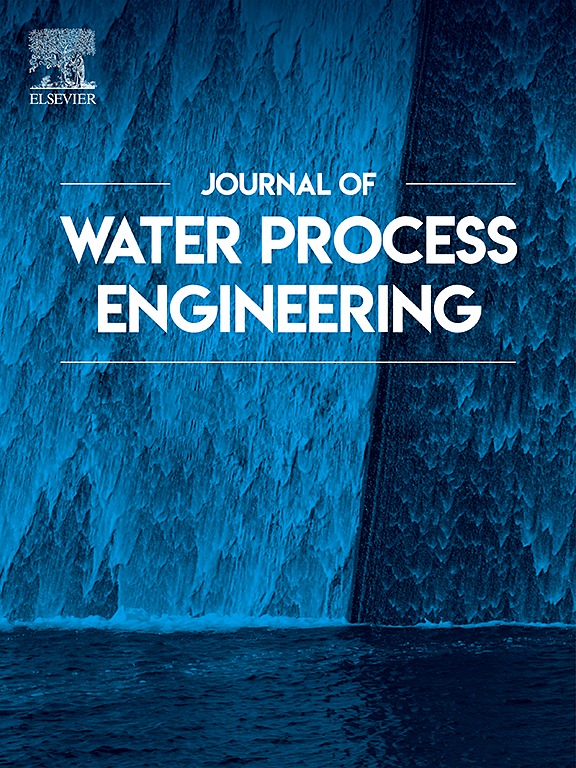Carbon paste electrode modified with Mn2O3 nanoparticles for simultaneous detection of heavy metals Cd(II) and Pb(II) in wastewater sample
IF 6.3
2区 工程技术
Q1 ENGINEERING, CHEMICAL
引用次数: 0
Abstract
A simple and efficient electrochemical sensor was developed to detect traces of Cd(II) and Pb(II) ions by modifying a carbon paste electrode (CPE) with manganese oxide nanoparticles (Mn2O3 NPs) synthesized via a precipitation method. These NPs, characterized by X-ray diffraction (XRD), scanning electron microscopy (SEM), Fourier transform infrared (FTIR) spectroscopy, and UV–visible spectroscopy, revealed a pure crystalline phase. The crystallite sizes, estimated at 62.25 nm and 30.84 nm using the Scherrer and Williamson-Hall equations, confirm their nanometric structure. FTIR spectra highlighted vibrations of Mn![]() O and Mn-O-Mn bonds, while UV–visible spectroscopy showed an absorption band at 388 nm and a secondary peak at 533 nm, indicating a bandgap energy (Eg) of 1.51 eV. The electrode modification was validated by cyclic voltammetry (CV), revealing a 34 % increase in the electroactive surface area (EASA), enhancing sensitivity for Cd(II) and Pb(II) detection. Detection was performed using square wave anodic stripping voltammetry (SWASV), and conditions (NPs mass, accumulation time and deposition potential) were optimized. The sensor demonstrated a working range of 0.1 μM to 100 μM with detection limits of 0.07 μM for Cd(II) and 0.19 μM for Pb(II). Interference studies have demonstrated the high sensitivity and selectivity of the sensors. Its feasibility was evaluated on real samples, including wastewater from Bni Bounsar (Morocco), using the standard addition method to minimize matrix effects. The obtained recovery rates ranging from 84 % to 95 % for Cd(II) and 80 % to 94 % for Pb(II), highlight its accuracy and reliability. These results confirm its applicability for environmental monitoring and the effective detection heavy metals.
O and Mn-O-Mn bonds, while UV–visible spectroscopy showed an absorption band at 388 nm and a secondary peak at 533 nm, indicating a bandgap energy (Eg) of 1.51 eV. The electrode modification was validated by cyclic voltammetry (CV), revealing a 34 % increase in the electroactive surface area (EASA), enhancing sensitivity for Cd(II) and Pb(II) detection. Detection was performed using square wave anodic stripping voltammetry (SWASV), and conditions (NPs mass, accumulation time and deposition potential) were optimized. The sensor demonstrated a working range of 0.1 μM to 100 μM with detection limits of 0.07 μM for Cd(II) and 0.19 μM for Pb(II). Interference studies have demonstrated the high sensitivity and selectivity of the sensors. Its feasibility was evaluated on real samples, including wastewater from Bni Bounsar (Morocco), using the standard addition method to minimize matrix effects. The obtained recovery rates ranging from 84 % to 95 % for Cd(II) and 80 % to 94 % for Pb(II), highlight its accuracy and reliability. These results confirm its applicability for environmental monitoring and the effective detection heavy metals.
纳米Mn2O3修饰碳糊电极同时检测废水样品中重金属Cd(II)和Pb(II
采用沉淀法合成的氧化锰纳米颗粒(Mn2O3 NPs)修饰碳糊电极(CPE),开发了一种简单高效的镉(II)和铅(II)离子检测传感器。通过x射线衍射(XRD)、扫描电子显微镜(SEM)、傅里叶变换红外光谱(FTIR)和紫外可见光谱对这些NPs进行了表征,发现它们具有纯晶相。根据Scherrer和Williamson-Hall方程,晶体尺寸分别为62.25 nm和30.84 nm,证实了它们的纳米结构。FTIR光谱显示了MnO和Mn-O-Mn键的振动,而紫外可见光谱显示了388 nm的吸收带和533 nm的次峰,表明带隙能量(Eg)为1.51 eV。通过循环伏安法(CV)验证了电极修饰的有效性,发现电活性表面积(EASA)增加了34%,提高了Cd(II)和Pb(II)检测的灵敏度。采用方波阳极溶出伏安法(SWASV)对NPs的质量、积累时间和沉积电位进行了优化。该传感器工作范围为0.1 μM ~ 100 μM,对Cd(II)和Pb(II)的检出限分别为0.07 μM和0.19 μM。干扰研究表明,该传感器具有较高的灵敏度和选择性。在实际样品上评估了其可行性,包括来自Bni Bounsar(摩洛哥)的废水,使用标准添加方法最小化基质效应。所得回收率分别为Cd(II)的84% ~ 95%和Pb(II)的80% ~ 94%,具有较高的准确性和可靠性。这些结果证实了该方法在环境监测中的适用性和对重金属的有效检测。
本文章由计算机程序翻译,如有差异,请以英文原文为准。
求助全文
约1分钟内获得全文
求助全文
来源期刊

Journal of water process engineering
Biochemistry, Genetics and Molecular Biology-Biotechnology
CiteScore
10.70
自引率
8.60%
发文量
846
审稿时长
24 days
期刊介绍:
The Journal of Water Process Engineering aims to publish refereed, high-quality research papers with significant novelty and impact in all areas of the engineering of water and wastewater processing . Papers on advanced and novel treatment processes and technologies are particularly welcome. The Journal considers papers in areas such as nanotechnology and biotechnology applications in water, novel oxidation and separation processes, membrane processes (except those for desalination) , catalytic processes for the removal of water contaminants, sustainable processes, water reuse and recycling, water use and wastewater minimization, integrated/hybrid technology, process modeling of water treatment and novel treatment processes. Submissions on the subject of adsorbents, including standard measurements of adsorption kinetics and equilibrium will only be considered if there is a genuine case for novelty and contribution, for example highly novel, sustainable adsorbents and their use: papers on activated carbon-type materials derived from natural matter, or surfactant-modified clays and related minerals, would not fulfil this criterion. The Journal particularly welcomes contributions involving environmentally, economically and socially sustainable technology for water treatment, including those which are energy-efficient, with minimal or no chemical consumption, and capable of water recycling and reuse that minimizes the direct disposal of wastewater to the aquatic environment. Papers that describe novel ideas for solving issues related to water quality and availability are also welcome, as are those that show the transfer of techniques from other disciplines. The Journal will consider papers dealing with processes for various water matrices including drinking water (except desalination), domestic, urban and industrial wastewaters, in addition to their residues. It is expected that the journal will be of particular relevance to chemical and process engineers working in the field. The Journal welcomes Full Text papers, Short Communications, State-of-the-Art Reviews and Letters to Editors and Case Studies
 求助内容:
求助内容: 应助结果提醒方式:
应助结果提醒方式:


